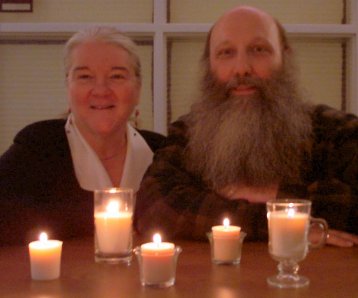
Introduction - Business Clusters In The Small
 Two of the hot topics today among regional and local economic developers are creative class and business cluster dynamics. In his award-winning book, The Rise of the Creative Class, Carnegie Mellon distinguished professor of regional economic development, Richard Florida, makes a compelling case for the counter-intuitive source of success factors in regional and local economies. Stuart Rosenfeld of Regional Technology Strategies (RTS), among others, champions the importance of recognizing business clusters, community ecosystems of associated businesses, as a dynamic source of regional and local economic well-being.
Two of the hot topics today among regional and local economic developers are creative class and business cluster dynamics. In his award-winning book, The Rise of the Creative Class, Carnegie Mellon distinguished professor of regional economic development, Richard Florida, makes a compelling case for the counter-intuitive source of success factors in regional and local economies. Stuart Rosenfeld of Regional Technology Strategies (RTS), among others, champions the importance of recognizing business clusters, community ecosystems of associated businesses, as a dynamic source of regional and local economic well-being.
 In both these important areas, creative class and business clusters, the collective power of the small is validated and encouraged. And in both these domains of new economic development thinking, the power and importance of networking is recognized. We are, indeed, in a new era of the Network Society and its associated Network Economy.
In both these important areas, creative class and business clusters, the collective power of the small is validated and encouraged. And in both these domains of new economic development thinking, the power and importance of networking is recognized. We are, indeed, in a new era of the Network Society and its associated Network Economy.
Many who have read Dr. Florida's book are left with a feeling of, "Great, that is fascinating... and very urban. What about folks like me that live in small towns and rural areas? How do creative class dynamics affect me?"
These are important and timely questions. At NARFI and Sohodojo, we've already written a few pieces describing tROCCits, or the Rise Of Creative Class in the small. For more on the implications of creative class dynamics in rural and distressed urban communities, see our Iowa Creative Economy Unconference presentation, and more recently, Nanocorps in Micropolis.
Adding Business Cluster Spice to Creative Class Chili
While Florida's theory can open our eyes to social and personal dynamics that affect regional economies, we need to turn to the emerging domain of business clusters to reveal additional insights about how creative class folks like to do business. Sure, some creative classers do work and enjoy working for large megacorps doing creative work 'in the large'. But more and more we find creative individuals in small business, including creative self-employment.
Many 'creatives' have been rugged individualists all along. But modern communication technologies and modern transportation systems make it increasingly possible for more folks to make their living in creative enterprises wherever they choose to be.

|
|
| RTS Cluster Guru Stuart Rosenfeld |
|---|
Recognizing that the geographic isolation and rural nature of much of the state had a significant impact on the health of Montana's economy, Chief Business Officer Dave Gibson of the Montana Governor's Office of Economic Opportunity turned to business cluster guru Stuart Rosenfeld and RTS Inc. to conduct a significant study of Montana's existing and potential business clusters. The result of this exhaustive study was The Montana Business Clusters Study document. A 52-page summary of the Montana Business Cluster Study is available in MS-Word (.doc) format.
| NARFI's Creative Enterprise Cluster Agenda | |
|
The Creative Enterprise Cluster (CEC) represents 5% of the employed workforce in Montana. The CEC makes a significant contribution to the Montana economy. With the emerging Network Society and Network Economy, the contribution of the Creative Enterprise Cluster to Montana's economy is likely to grow and broaden. The CEC has the potential to invigorate local and regional economies in our rural and reservation communities. The North American Rural Futures Institute (NARFI) has an active and evolving Creative Enterprise Cluster research and social action agenda in collaboration with its strategic partners, Sohodojo and The Richard Florida Creativity Group. For details of NARFI's Creative Enterprise Cluster agenda, follow the above links to relevant sections of the NARFI Program Update. |
Rosenfeld's RTS study identified six clusters in Montana: the Wood-Based Product Cluster, Agri-Food Cluster, Experience Enterprise and Tourism Cluster, Life Sciences Cluster, Information Technology Cluster, and Creative Enterprise Cluster. The first five clusters are relatively conventional and expected given Montana's resource-based industries, agriculture, tourism and the ubiquitious reach of technology industries. It is the sixth cluster, the Creative Enterprise Cluster, that is especially interesting as an emerging 'new kid on the block' in cluster business analyses.
While geographic concentration is a primary feature of most business clusters, the Creative Enterprise Cluster transcends space – Who, What and Why are more important than Where and How Much. Shared interests defines the bond of community of the creative individuals and small businesses that comprise the Creative Enterprise Cluster. Once overlooked and dismissed as marginal contributors to local and regional economic vitality, creative researchers such as Richard Florida and Stuart Rosenfeld are shining a bright and constructive light on the self-employed and very small businesses that make up the Creative Enterprise Cluster.
The following is the chapter on the Creative Enterprise Cluster excerpted from the Summary of the Montana Business Cluster Study by Stuart Rosenfeld and the staff of RTS. While this analysis is specific to Montana, the concepts and insights are applicable to Creative Enterprises everywhere. Does your state have a Creative Enterprise Cluster analysis and action agenda?
Montana's Creative Enterprise Cluster Input/Output Diagram

Montana's Creative Enterprise Cluster
| "The creative centers tend to be the economic winners of our age." Richard Florida
The Rise of the Creative Class, 2002 |
Description
In Montana, the companies and individuals that produce and use creativity of form, design, sound, and language are the basis for the creative enterprise cluster. This cluster consists of all enterprises in the state whose principal competitive advantages are derived from distinctive appearance, form, or content.
 The cluster accounts
for more than four percent of the state
The cluster accounts
for more than four percent of the state
 NARFI's's Timlynn and Jim are featured in a front page story in the Havre Daily News! Tim Leeds writes about the new twist on medieval craft guilds, Richard Florida's creative class and rural entrepreneurism in his excellent article announcing the founding of Big Sky Chandlers, a microenterprise network being formed along the northcentral Montana Hi-Line as a 'hub' of the
NARFI's's Timlynn and Jim are featured in a front page story in the Havre Daily News! Tim Leeds writes about the new twist on medieval craft guilds, Richard Florida's creative class and rural entrepreneurism in his excellent article announcing the founding of Big Sky Chandlers, a microenterprise network being formed along the northcentral Montana Hi-Line as a 'hub' of the 